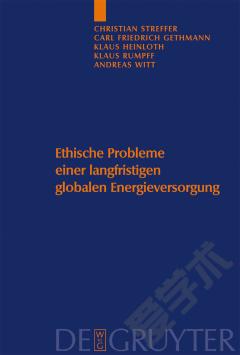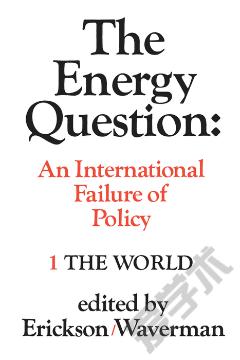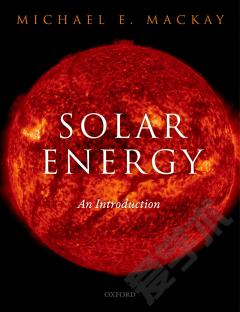Introduction to Global Energy Issues
Preface (by Jean-Arnold Vinois, Honorary Director at the European Commission, Former Director of the internal energy market within the Directorate General for Energy) Acronyms About the authors 1 Introduction 1.1 Overall presentation 1.2 Structure of the book 1.3 Educational use of this book 1.3.1 Recommended pedagogy 1.3.2 Available Diapason sessions 1.4 Energy and economic statistics 2 Energy sectors 2.1 Presentation 2.2 Forms of energy 2.3 Conversion of energy 2.4 Main sources of energy 2.4.1 Oil 2.4.2 Natural gas 2.4.3 Coal 2.4.4 Non-conventional fuels 2.4.5 Nuclear energy 2.4.6 Renewable energies 2.5 Electricity production 2.5.1 Thermal power plants 2.5.2 Production management 2.5.3 Transport and distribution 2.5.4 Cost structure 2.5.5 Conclusion 2.6 Thermal or pneumatic energy storage 2.7 Common characteristics and comparisons 2.7.1 Implementation time 2.7.2 Diversity and rigidity 2.7.3 Social acceptance 2.7.4 Comparisons between sectors 2.8 Conclusion References Further reading 3 Macroeconomic indicators and accounting of energy 3.1 Presentation 3.2 Evolution of the world population 3.3 Basics 3.3.1 Gross Domestic Product 3.3.2 Gross National Product, Gross National Income 3.3.3 International comparisons 3.3.4 Economic growth and development 3.3.5 Human Development Index 3.4 Structure of GDP 3.5 Energy accounting, energy chain 3.5.1 Accounting problems 3.5.2 Flow graphs 3.6 Energy intensity 3.6.1 Definition of the energy intensity 3.6.2 World energy intensities 3.6.3 Income elasticity 3.6.4 Relationship between growth rates 3.6.5 GDP and energy in France 3.6.6 Energy intensity changes of OECD countries 3.6.7 Convergence of world energy intensity 3.6.8 Changes in the electricity content of GDP 3.7 Indicators for CO2 emissions 3.8 Energy markets 3.8.1 International trade 3.8.2 Oil market 3.8.3 Natural gas market 3.8.4 Coal market 3.8.5 Conclusion on the energy markets References Further reading 4 The impact of energy on economic development 4.1 Presentation 4.2 Energy consumption and income level 4.2.1 Factors of development 4.2.2 Evolution of energy consumption 4.3 Coal and industrial revolution 4.4 Work/energy substitution 4.5 Reduction of transportation cost 4.6 An anecdotal illustration 4.7 Energy uses 4.8 Mechanisms of formation of energy demand 4.8.1 Breaking down demand 4.8.2 Determinants of aggregate demand 4.9 Macro-economic impacts of energy 4.9.1 Energy sector 4.9.2 Non-energy productive sector 4.9.3 Impact on investment 4.9.4 Impact on the balance of payments 4.9.5 Impact on consumers 4.9.6 Impact on state revenue References Further reading 5 Energy policy 5.1 Presentation 5.2 Limitations of the energy policy 5.3 Main objectives of the energy policy 5.4 Energy policy 5.4.1 Planning process 5.4.2 Energy models 5.5 Pricing elements 5.5.1 Economist pricing approach 5.5.2 Political approach to pricing 5.5.3 Practical difficulties of pricing 5.6 Institutional aspects 5.6.1 Need for joint action levels on supply and demand 5.6.2 Organization of national energy systems 5.6.3 Relationship between the central administration and operators 5.7 Conclusion References Further reading 6 World energy situation 6.1 Presentation 6.2 Consumption and production 6.2.1 Primary energy consumption in the world 6.2.2 Historical trends 6.2.3 Distribution of per capita consumption 6.2.4 Regional distribution 6.2.5 Production and consumption by region 6.2.6 Production and consumption by country groups 6.3 Energy reserves and resources 6.3.1 Definitions 6.3.2 Reserves of oil and natural gas 6.3.3 McKelvey diagram 6.3.4 Proved reserves 6.3.5 Resources 6.4 Energy problems in developing countries 6.4.1 Definition 6.4.2 Dual societies 6.4.3 Oil importers DCs 6.4.4 Energy problems of the poorest 6.4.5 The firewood crisis 6.4.6 Commercial energy needs 6.4.7 Energy characteristics of developing countries References Further reading 7 Case studies: The energy situation in certain countries 7.1 Algeria 7.2 Brazil 7.3 China 7.4 Cote d'Ivoire 7.5 France 7.6 India 7.7 Indonesia 7.8 Russia 7.9 South Africa 7.10 United Kingdom 7.11 United States 7.12 Energy in Europe 7.12.1 Evolution through the years 7.12.2 Outline of the European energy policy 7.13 Conclusion References 8 Recent developments: New dimensions of the energy problem 8.1 Presentation 8.2 Environmental issues 8.2.1 Impact of energy on the atmosphere 8.2.2 General remarks on additional environmental impacts of energy 8.2.3 Possible solutions 8.3 Changing technology 8.3.1 Introduction 8.3.2 Exploration and production in the oil sector 8.3.3 Improved combustion 8.3.4 Production of electricity from natural gas 8.3.5 Reduction of specific energy consumption 8.3.6 Carbon capture and storage 8.4 A chronically unstable oil market 8.4.1 Consequences on the demand to OPEC 8.4.2 The peak oil debate 8.4.3 Interaction between oil demand and price References Further reading 9 Outlook 9.1 Presentation 9.2 Energy scenarios 9.2.1 Long-term scenarios (2100) 9.2.2 Medium term scenarios (2030-2050) 9.3 Major trends 9.3.1 A sharp increase in energy consumption 9.3.2 A growing levy on world wealth 9.3.3 Adequate resources at the scale of the planet 9.3.4 Concern over the environmental impact 9.3.5 Reducing the energy content of GDP 9.3.6 A continued leading role for oil 9.3.7 Persistence of geopolitical constraints 9.3.8 Continuation of a sustained technological development effort References Further reading Annex 1: Pedagogical remarks A1.1 Innovative pedagogy A1.2 Learning objectives A1.2.1 Memory A1.2.2 Understanding A1.2.3 Know-how A1.2.4 Capacity for analysis and synthesis Annex 2: Energy units and conversion factors A2.1 Basic units A2.1.1 Joule A2.1.2 Calorie A2.1.3 British Thermal Unit A2.1.4 kWh A2.2 Derived units A2.3 Conversion factors A2.3.1 Oil A2.3.2 Natural gas A2.3.3 Coal A2.3.4 Electricity Subject index
{{comment.content}}








 京公网安备 11010802027623号
京公网安备 11010802027623号